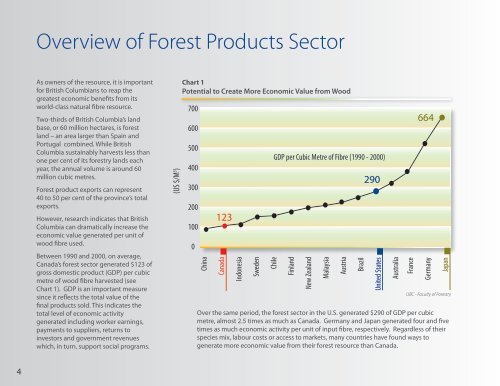Generating More Value from Our Forests - Ministry of Forests
Generating More Value from Our Forests - Ministry of Forests
Generating More Value from Our Forests - Ministry of Forests
You also want an ePaper? Increase the reach of your titles
YUMPU automatically turns print PDFs into web optimized ePapers that Google loves.
3<br />
4<br />
Overview <strong>of</strong> Forest Products Sector<br />
As owners <strong>of</strong> the resource, it is important<br />
for British Columbians to reap the<br />
greatest economic benefits <strong>from</strong> its<br />
world-class natural fibre resource.<br />
Two-thirds <strong>of</strong> British Columbia’s land<br />
base, or 60 million hectares, is forest<br />
land -- an area larger than Spain and<br />
Portugal combined. While British<br />
Columbia sustainably harvests less than<br />
one per cent <strong>of</strong> its forestry lands each<br />
year, the annual volume is around 60<br />
million cubic metres.<br />
Forest product exports can represent<br />
40 to 50 per cent <strong>of</strong> the province’ s total<br />
exports.<br />
However, research indicates that British<br />
Columbia can dramatically increase the<br />
economic value generated per unit <strong>of</strong><br />
wood fibre used.<br />
Between 1990 and 2000, on average,<br />
Canada’s forest sector generated $123 <strong>of</strong><br />
gross domestic product (GDP) per cubic<br />
metre <strong>of</strong> wood fibre harvested (see<br />
Chart 1). GDP is an important measure<br />
since it reflects the total value <strong>of</strong> the<br />
final products sold. This indicates the<br />
total level <strong>of</strong> economic activity<br />
generated including worker earnings,<br />
payments to suppliers, returns to<br />
investors and government revenues<br />
which, in turn, support social programs.<br />
(US $/M 3 )<br />
Chart 1<br />
Potential to Create <strong>More</strong> Economic <strong>Value</strong> <strong>from</strong> Wood<br />
700<br />
600<br />
500<br />
400<br />
300<br />
200<br />
100<br />
0<br />
China<br />
123<br />
Canada<br />
Indonesia<br />
Sweden<br />
Chile<br />
GDP per Cubic Metre <strong>of</strong> Fibre (1990 - 2000)<br />
Finland<br />
New Zealand<br />
Malaysia<br />
Austria<br />
Brazil<br />
290<br />
United States<br />
Australia<br />
France<br />
664<br />
Germany<br />
Japan<br />
UBC - Faculty <strong>of</strong> Forestry<br />
Over the same period, the forest sector in the U.S. generated $290 <strong>of</strong> GDP per cubic<br />
metre, almost 2.5 times as much as Canada. Germany and Japan generated four and five<br />
times as much economic activity per unit <strong>of</strong> input fibre, respectively. Regardless <strong>of</strong> their<br />
species mix, labour costs or access to markets, many countries have found ways to<br />
generate more economic value <strong>from</strong> their forest resource than Canada.

















